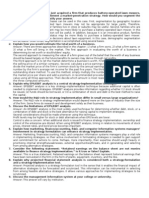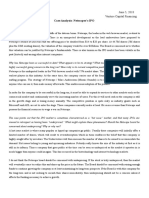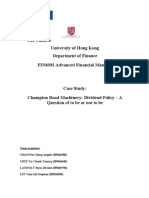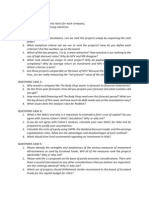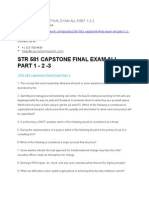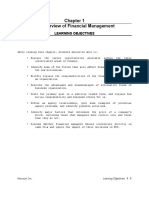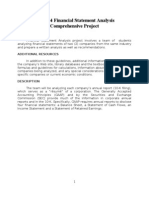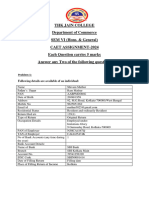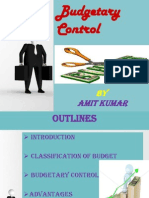Module 4 Guideline Case Questions PDF
Module 4 Guideline Case Questions PDF
Uploaded by
Areeb JavaidCopyright:
Available Formats
Module 4 Guideline Case Questions PDF
Module 4 Guideline Case Questions PDF
Uploaded by
Areeb JavaidOriginal Description:
Original Title
Copyright
Available Formats
Share this document
Did you find this document useful?
Is this content inappropriate?
Copyright:
Available Formats
Module 4 Guideline Case Questions PDF
Module 4 Guideline Case Questions PDF
Uploaded by
Areeb JavaidCopyright:
Available Formats
FINN 400 APPLIED CORPORATE FINANCE Spring 2013
Module 4: Financing, Capital Structure, and Dividend Policy Decisions
Session 13 - Case: Debt Policy at UST Inc. Suggested Questions: 1. What are the primary business risks associated with UST Inc.? What are the attributes of UST Inc.? Evaluate from the viewpoint of a bondholder. 2. Why is UST Inc. considering a leveraged recapitalization after such a long history of conservative debt policy? 3. Should UST Inc. undertake the $1 billion recapitalization? Calculate the marginal (or incremental) effect on USTs value, assuming that the entire recapitalization is implemented immediately (January 1, 1999). (a) Assume a 38% tax rate. (b) Prepare a pro-forma income statement to analyze whether UST will be able to make interest payments. (c) For the basic analysis, assume the $1 billion in new debt is constant and perpetual. Should UST alter the new debt via a different level or a change in the amount of debt through time. 4. UST Inc. has paid uninterrupted dividends since 1912. Will the recapitalization hamper future dividend payments? Session 14 - Case: AMG, Inc. & Forsythe Solutions Suggested Questions: 1. 2. 3. 4. Should you recommend leasing or purchasing the PCs? Why? Why are the debt rates different for hardware and software leased over the same term? Qualitatively explain if you should choose a rolling or coterminous lease and why. Which is more advantageous, quarterly or monthly takedowns? Explain qualitatively and quantitatively. 5. If you decide on leasing, which payment schedule and leaseline are most appropriate and why? 6. How much would Forsythe make on the AMG deal? 7. What are the key takeaways to remember when determining future lease versus buy decisions of this magnitude?
Session 15 - Case: Dividend Policy at FPL Group, Inc Suggested Questions: 1. What do firms pay dividends? What, in general, are the advantages and disadvantages of paying cash dividends? 2. What are the most important issues confronting the FPL Group in May 1994? 3. From FPLs perspective, is the current payout ratio appropriate? Would a higher payout ratio be more appropriate? A lower payout ratio? 4. From an investors perspective, is FPLs payout ratio appropriate? 5. As Kate Stark, what would you recommend regarding investment in FPLs stock buy, sell, or hold?
Session 16 - Case: Netscapes Initial Public Offering Suggested Questions: 1. Why has Netscape been so successful to date? What appears to be its strategy? What must be accomplished if it is to be a highly successful going concern in the long run? How risky is its current competitive position? 2. Does Netscape need to go public to satisfy its capital needs? What would you estimate might be the magnitude of its capital needs over the next 3 to 5 years? What sources other than the public equity market could be tapped to satisfy those needs? 3. Why, in general, do companies go public? What are the advantages and disadvantages of public ownership? 4. The case points out that the IPO market is sometimes characterized as hot issue market, and that many IPO are viewed in retrospect as having been underpriced. What might explain these phenomena? Should the Netscape hoard be concerned about underpricing? Why or why not? 5. Can the recommended offering price of $28 per share for Netscapes stock be justified? In valuing Netscape, you might find it helpful to use the following assumptions: Total cost of revenues remains at 10.4% of total revenues; R&D remains at 36.8% of total revenues; Other operating expenses decline on a straight-line basis from 80.9% of revenues in 1995 to 20.9% of revenues in 2001 (this would give Netscape a ratio of operating income to revenues close to Microsofts, which is about 34%); Capital expenditures decline from 45.8% of revenues in 1995 to 10.8% of revenues by 2001 (again, close to Microsofts experience); Depreciation is held constant at 5.5% of revenues;
Changes in net working capital of essentially zero; Long-term steady-state growth of 4% annually after 2005; and A long-term riskless interest rate of 6.71%. Given these assumptions, and starting from its current sales base of $16.625 million, how fast must Netscape grow on an annual basis over the next ten years to justify a $28 share value? 6. As an executive of Netscape, what would you recommend with respect to the proposed offering price? As an investor in Netscape, what would you recommend? As the manager of an institutional fund who was willing to buy and hold Netscapes stock at the originally proposed price of $14 per share, would you willing to buy and hold at an initial offering price of $28 per share?
You might also like
- Strategy Papers and Cases QuestionsDocument9 pagesStrategy Papers and Cases QuestionsMuhammad Ahmed0% (1)
- Case QuestionsDocument10 pagesCase QuestionsJeremy SchweizerNo ratings yet
- Customer Preference in Foodservice Industry in Davao CityDocument20 pagesCustomer Preference in Foodservice Industry in Davao CityRaven John Fuentes100% (3)
- Case QuestionsDocument5 pagesCase Questionsaditi_sharma_65No ratings yet
- Cases Qs MBA 6003Document5 pagesCases Qs MBA 6003Faria CHNo ratings yet
- Questions For Preparation Macr 2019Document4 pagesQuestions For Preparation Macr 2019Abhay PrakashNo ratings yet
- CH 8Document2 pagesCH 8Abbas Ali100% (6)
- Netscape HomeworkDocument3 pagesNetscape HomeworkJaime Zulueta0% (2)
- FPL Dividend Policy-1Document6 pagesFPL Dividend Policy-1DavidOuahba100% (1)
- Alex Navab - Overview of Private EquityDocument21 pagesAlex Navab - Overview of Private EquityAlyson Davis100% (16)
- Champion Road Case Report v6Document19 pagesChampion Road Case Report v6h9902600No ratings yet
- 2019SKFTrainingHandbook 1115 PDFDocument96 pages2019SKFTrainingHandbook 1115 PDFWilliams GarciaNo ratings yet
- IB Assignment (20%)Document1 pageIB Assignment (20%)Vasundhara ChaturvediNo ratings yet
- Suraj Lums Edu PKDocument9 pagesSuraj Lums Edu PKalice123h21No ratings yet
- Case QuestDocument6 pagesCase QuestAbdul Kodir0% (1)
- UntitledDocument13 pagesUntitledJocelyn GiselleNo ratings yet
- 1103 CaseDocument8 pages1103 Casezmm45x7sjtNo ratings yet
- Case QuestionsDocument3 pagesCase Questionstumere_jahe0% (1)
- Questions For The Cases 125810 2024Document7 pagesQuestions For The Cases 125810 2024karthicktherulingrascalNo ratings yet
- Chapter 6 Prospective Analysis: ForecastingDocument10 pagesChapter 6 Prospective Analysis: ForecastingSheep ersNo ratings yet
- 06 AnsDocument4 pages06 AnsAnonymous 8ooQmMoNs1No ratings yet
- Investment Banking: Individual Assignment 2Document5 pagesInvestment Banking: Individual Assignment 2Aakash Ladha100% (3)
- STR 581 Capstone Final Exam All Part 1-2-3Document7 pagesSTR 581 Capstone Final Exam All Part 1-2-3johnNo ratings yet
- Assessment Task 3 - Individual AssignmentDocument5 pagesAssessment Task 3 - Individual AssignmentMashavia AhmadNo ratings yet
- FINA 6092 Case QuestionsDocument7 pagesFINA 6092 Case QuestionsKenny HoNo ratings yet
- FM2 Câu hỏi ôn tậpDocument7 pagesFM2 Câu hỏi ôn tậpĐoàn Trần Ngọc AnhNo ratings yet
- FM - Sunita Mahajan PGPMX B2-18-20 - Individual AssignmentDocument8 pagesFM - Sunita Mahajan PGPMX B2-18-20 - Individual AssignmentSunita Mahajan PGPMX 2018 B2No ratings yet
- 2023 EBAD401 - Chapter 4 PPT LecturerDocument55 pages2023 EBAD401 - Chapter 4 PPT Lecturermaresa bruinersNo ratings yet
- 2 - 16th April 2008 (160408)Document5 pages2 - 16th April 2008 (160408)Chaanakya_cuimNo ratings yet
- Ch1 MCDocument10 pagesCh1 MCbuitri758No ratings yet
- Case Assignment Questions ALL PDFDocument26 pagesCase Assignment Questions ALL PDFMiscue JoNo ratings yet
- Chapter 11Document4 pagesChapter 11محمد الجمريNo ratings yet
- PSPC Activist Shareholders Group: Presentation of Demands To The ManagementDocument19 pagesPSPC Activist Shareholders Group: Presentation of Demands To The Managementανατολή και πετύχετεNo ratings yet
- 1 An Overview of Financial ManagementDocument14 pages1 An Overview of Financial ManagementSadia AfrinNo ratings yet
- Exam Focus - May 2010 Strategic Level Exams and The New Pre-Seen Case StudyDocument4 pagesExam Focus - May 2010 Strategic Level Exams and The New Pre-Seen Case StudynirudafatNo ratings yet
- Business FinanceDocument7 pagesBusiness Financeparthasdhar8No ratings yet
- Banking Interviews Guide-2Document4 pagesBanking Interviews Guide-2SAKSHAM SINGHNo ratings yet
- Financial Decision MakingDocument2 pagesFinancial Decision Makingzaigham abbasNo ratings yet
- Problems and Questions - 3Document6 pagesProblems and Questions - 3mashta04No ratings yet
- A Suggested Format For The Company Analysis ReportDocument4 pagesA Suggested Format For The Company Analysis ReportPrasanth VngNo ratings yet
- Financial Statement Analysis Project - Fall 2012-1Document9 pagesFinancial Statement Analysis Project - Fall 2012-1rajesh934No ratings yet
- FPL Case Submission MS19A001Document10 pagesFPL Case Submission MS19A001karanNo ratings yet
- FIN 534 GENIUS Expect Success Fin534geniusdotcomDocument31 pagesFIN 534 GENIUS Expect Success Fin534geniusdotcomisabella45No ratings yet
- Summary 8 2018Document4 pagesSummary 8 2018Stanley HoNo ratings yet
- QuestionsDocument2 pagesQuestionsRza Rustamli0% (2)
- Corporate Valutation 5ed - Study HelpDocument31 pagesCorporate Valutation 5ed - Study HelpzyndicateNo ratings yet
- Case Infineon Technologies - Support QuestionsDocument1 pageCase Infineon Technologies - Support QuestionsnovasbechatgptNo ratings yet
- Intermediate Financial Management 12th Edition Brigham Solutions Manual PDF Download Full Book with All ChaptersDocument51 pagesIntermediate Financial Management 12th Edition Brigham Solutions Manual PDF Download Full Book with All Chapterstripplikos5h100% (1)
- Country Evaluation and SelectionDocument39 pagesCountry Evaluation and SelectionAustin Oliver0% (1)
- Group Project FIN9781Document3 pagesGroup Project FIN9781deep85.mastersNo ratings yet
- 7I Important Questions With Solution of FM Covering 50 Marks 8C70248ADocument88 pages7I Important Questions With Solution of FM Covering 50 Marks 8C70248APoorna LakshmiNo ratings yet
- Implementing Strategies: Marketing, Finance/Accounting, R&D, and MIS IssuesDocument58 pagesImplementing Strategies: Marketing, Finance/Accounting, R&D, and MIS Issuesdonna mendozaNo ratings yet
- Fin622 QuizDocument59 pagesFin622 Quizwqas_akramNo ratings yet
- 2009-04-03 181856 ReviewDocument18 pages2009-04-03 181856 ReviewAnbang XiaoNo ratings yet
- Breaking Into WS 1-HR LBO-Modeling-Test-AnswDocument3 pagesBreaking Into WS 1-HR LBO-Modeling-Test-AnswANo ratings yet
- Finn 22 - Financial Management Questions For Chapter 2 QuestionsDocument4 pagesFinn 22 - Financial Management Questions For Chapter 2 QuestionsJoongNo ratings yet
- Private Equity QuestionsDocument74 pagesPrivate Equity QuestionsKumar PrashantNo ratings yet
- Finance Assignment Ratio - Financial ManagementDocument9 pagesFinance Assignment Ratio - Financial ManagementKelly Brook100% (3)
- Exam 3 Practice Problems 2023Document1 pageExam 3 Practice Problems 2023monikaevanekNo ratings yet
- Ebook ChaptersDocument86 pagesEbook Chaptersabhijeet_rahate36No ratings yet
- The Well-Timed Strategy (Review and Analysis of Navarro's Book)From EverandThe Well-Timed Strategy (Review and Analysis of Navarro's Book)No ratings yet
- (E) OA Catalog V7.3 72dpiDocument8 pages(E) OA Catalog V7.3 72dpiNguyen TranNo ratings yet
- Belgium PDFDocument2 pagesBelgium PDFBrandon HaleNo ratings yet
- Non Impairment ClauseDocument5 pagesNon Impairment ClauseBananaNo ratings yet
- Sujani PrattipatiDocument2 pagesSujani PrattipatiSujani PrattipatiNo ratings yet
- G.R. No. L-22456Document5 pagesG.R. No. L-22456Raf RufNo ratings yet
- Itr Fy 22-23-1Document5 pagesItr Fy 22-23-1Omkar kaleNo ratings yet
- FloatDocument6 pagesFloataakash3978No ratings yet
- Ceo 13Document1 pageCeo 13Arsh AhmadNo ratings yet
- Caet AssignmentDocument3 pagesCaet Assignmentshubhasishpoddar40% (1)
- Unit-I Introduction To Erp Enterprise Resource Planning (ERP) Is An Integrated Computer-Based SystemDocument51 pagesUnit-I Introduction To Erp Enterprise Resource Planning (ERP) Is An Integrated Computer-Based Systemchandru5g100% (4)
- Chapter 7: Writing Routine and Positive MessagesDocument9 pagesChapter 7: Writing Routine and Positive Messageskocogituyetdoi_29115961No ratings yet
- Chateau Royale V Barba and Constante 2017Document2 pagesChateau Royale V Barba and Constante 2017idemsonamNo ratings yet
- Dissertation Topics in EntrepreneurshipDocument4 pagesDissertation Topics in EntrepreneurshipWhitePaperWritingServicesSingapore100% (1)
- Genie 2632 Bill of SaleDocument2 pagesGenie 2632 Bill of SaleScott BoogemansNo ratings yet
- Budgetary ControlDocument16 pagesBudgetary Controler_rimjhimsinghNo ratings yet
- Ethical IssuesDocument3 pagesEthical IssuesGabrielle Beatrice Tronco100% (1)
- Bubble TeaDocument9 pagesBubble TeaDania UzairNo ratings yet
- Asynchronous - 01Document8 pagesAsynchronous - 01Joshua SantiagoNo ratings yet
- Essentials of Good Financial Statements, Types of Financial AnalysisDocument2 pagesEssentials of Good Financial Statements, Types of Financial Analysiskreshmith2No ratings yet
- Organizing For Global MarketingDocument18 pagesOrganizing For Global MarketingNabila HudaNo ratings yet
- GF&Co: Initial Comment's On BlackRock's Housing Finance Reforms PaperDocument15 pagesGF&Co: Initial Comment's On BlackRock's Housing Finance Reforms PaperJoshua RosnerNo ratings yet
- Air India Air Transport Services LimitedDocument5 pagesAir India Air Transport Services LimitedSumit KumarNo ratings yet
- Tut 2Document2 pagesTut 2Rao BilalNo ratings yet
- Planning and Scheduling Summary: InputsDocument1 pagePlanning and Scheduling Summary: InputsKate Nazareno FlorendoNo ratings yet
- Activity: Type of Transactions Proper Journal Entry (Entries)Document2 pagesActivity: Type of Transactions Proper Journal Entry (Entries)Joannah maeNo ratings yet
- The Golden Ratio - Fibonacci in The Financial Markets PDFDocument21 pagesThe Golden Ratio - Fibonacci in The Financial Markets PDFJeRve CullatNo ratings yet
- Business Communication PDFDocument312 pagesBusiness Communication PDFKunal YadavNo ratings yet
- Garden Reach Shipbuilders & Engineers LimitedDocument63 pagesGarden Reach Shipbuilders & Engineers LimitedSRARNo ratings yet







